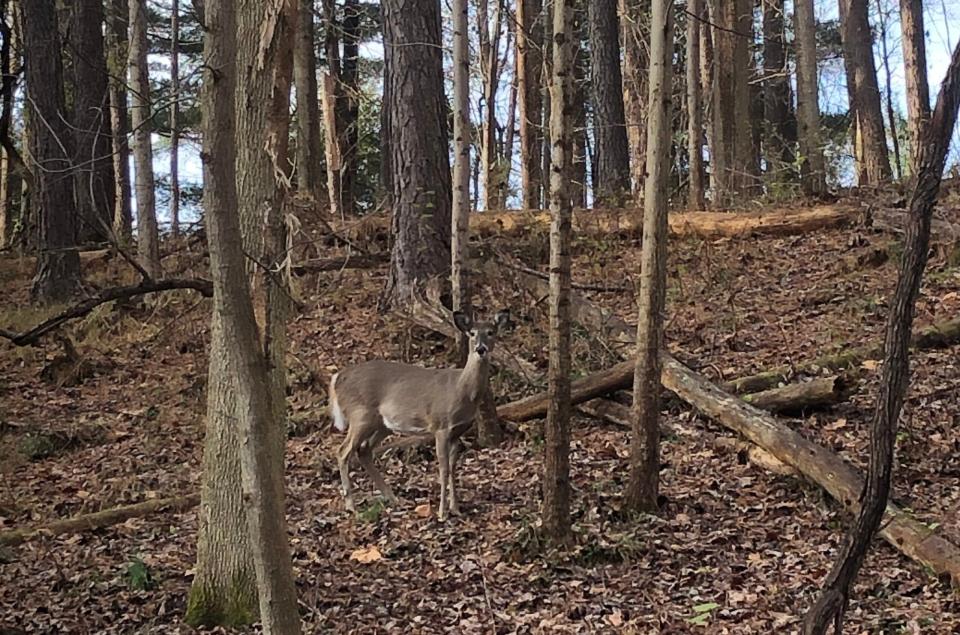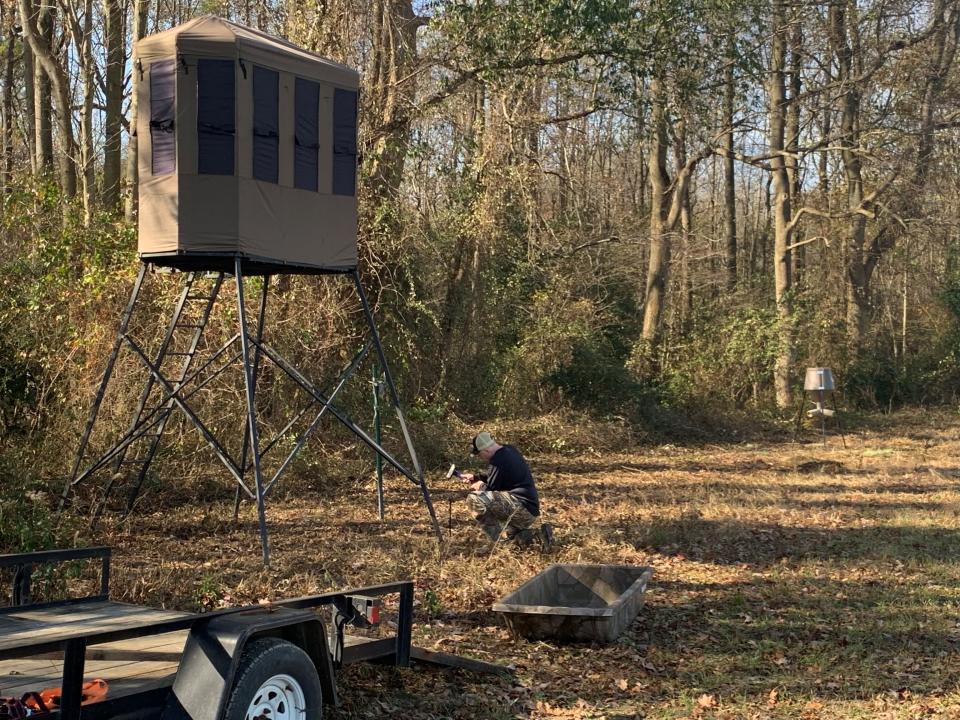Be alert! Deer breeding season brings rise in Maryland crashes. Here's what to know
It was late at night in November 2021 when Carl Wagner was driving down Central Avenue in Edgewater, Maryland, on his way home to Harwood, Maryland, in his Ford F-150. Suddenly a deer leaped a guardrail and darted in front of his truck.
The buck was thrown into the air, then walked a little ways off and died by the side of the road. Luckily, Wagner, a member of the Wildlife Advisory Commission and head of the Maryland Sportsmen’s Foundation, was OK, but his truck sustained $5,000 to $6,000 in damage.
“He caved in the whole grill,” Wagner said. The deer damaged the turbo part of the engine and crunched the left quarter panel, he said. “He broke the headlight. … He smashed the hood. … So he did substantial damage.”
Peak of deer breeding season escalates collisions in Maryland

The crash happened in November, the peak of deer breeding season, a period marked by increased deer activity starting in late October and lasting until mid-December. Deer breeding season, also known as the rut, brings an increase in deer-vehicle collisions across Maryland.
According to Jonathan Trudeau, game mammal section leader for the Maryland Department of Natural Resources’ Wildlife and Heritage Service, deer behavior is more risky during the breeding season.
“During that period, males are pushing females around, they themselves are running across areas that they otherwise wouldn't have, they take riskier actions that they probably normally wouldn't,” Trudeau said. “It's because those males are actively pursuing females and females are being chased by males in the attempt to breed them.”
This increase in deer activity in the later months of the year puts drivers at higher risk for deer-vehicle collisions. Deer are most active in the early morning hours between 5 and 8 a.m. and again between 5 and 8 p.m.
Strategies to help avoid crashes with deer
In order to avoid striking a deer during these busy commuting hours, Ragina Ali, public and government affairs manager for the American Automobile Association - Mid Atlantic, recommends continuously sweeping your eyes across the road to see if there are signs of animals.
“(Deer) rarely travel alone, so if you see one there are likely one or more nearby, so if you see one, make sure you slow down,” Ali said. “If an animal is in your path, make sure you stay in your lane. Swerving away from the animals can not only confuse them … but it can also put you in further danger by putting you in the path of oncoming vehicles.”
SALISBURY'S MAYORAL RACE: Salisbury mayoral candidates talk downtown development, crime and economics in SU forum
SHORE'S VITAL ROLE IN A PEACE ACCORD: Wrestling through the night: Wye River and Maryland’s role in 1990s Middle East peace deal
While many crashes occur when animals dart in front of a car — like Wagner’s crash — Ali said it’s important to remember that they can also run into the side of a car.
Maryland ranked 28th in the country in animal collisions, according to State Farm, with the likelihood of a claim involving an animal at 1 in 116.
Insurance claim costs related to crashes with animals on the rise
According to AAA, the cost of an insurance claim related to animal strikes has increased by nearly 60% in the last five years. The average cost of a claim for an animal-vehicle collision was $3,972 in 2018, increasing to $6,343 in 2022.
This bump in the cost of claims is due in part to more advanced vehicle technology that costs more to replace following a collision.
“The very same technology that's in vehicles to help keep us safe, such as cameras and sensors, those items may be also in the windshield or bumper or rearview mirrors,” Ali said. “Even for what will typically maybe be a fender bender, if you strike a deer, those things may in fact need to be repaired, if not replaced, and they're certainly more expensive to do that.”
How hunting helps manage deer to prevent overpopulation

While deer activity may rise in the next few months, the statewide deer population has been consistent. Maryland’s deer population peaked in the early 2000s with a herd of nearly 300,000, but has since held steady at about 230,000, Trudeau said.
Deer numbers in Maryland are managed to prevent overpopulation. By maintaining the herd, the Department of Natural Resources is able to mitigate the impact deer have on the environment, agriculture and human activity. The deer population is largely maintained through recreational hunting across the state.
“Essentially hunters act as the top predator of white-tailed deer, and if we do not keep the population in check the population will boom,” Trudeau said. “And you start to have a cycle, essentially, where you have so many deer that they, essentially, would eat themselves out of house and home, and we would see numbers way beyond what would be socially acceptable by the human public.”
“We need to harvest a certain amount of animals, deer in particular, yearly in order to keep them from being overpopulating and damaging, either crop lands or woodlands,” Wagner said. “The capacity of the land can't handle the capacity of the deer that are out there at times.”
During the combined archery, muzzleloader and firearm seasons from Sept. 9, 2022, to Feb. 3, 76,687 deer were harvested, an 8% increase over the previous season.
“(Hunting is) a huge contributor to our deer herd management and success in stabilizing our deer herd in many parts of the state,” Trudeau said. “Without hunters, we would not be able to do that and it's really one of the only effective tools that we have (for) managing deer at that scale.”
WOMEN WHO HUNT IN MD.: 'We can get our hands dirty.' Women who hunt on the rise
MORE ON FEEDING THE HUNGRY: How hunters are taking aim at hunger and feeding Marylanders
Farmers and Hunters Feeding the Hungry, an organization that allows hunters to bring slain animals into participating butchers to be donated to local food banks across Maryland, sees an increase in donations during the rut.
“The largest concentration (of donations) would come in Maryland anyway, and in most states, right after Thanksgiving for us when firearm season starts,” said Josh Wilson, executive director of Farmers and Hunters Feeding the Hungry. “The bulk of the deer harvest takes place during those couple of weeks.”
During the 2022 to 2023 hunting season, Wilson said, 1,197 deer were donated, and over 35,000 pounds of meat was donated to over 30 Maryland food banks.
This article originally appeared on Salisbury Daily Times: Maryland deer breeding season escalates crashes, so be alert now

